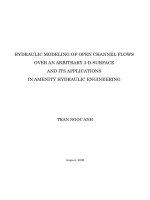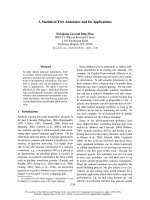Functionalized quantum dots and its applications
Bạn đang xem bản rút gọn của tài liệu. Xem và tải ngay bản đầy đủ của tài liệu tại đây (1.55 MB, 124 trang )
FUNCTIONALIZED QUANTUM DOTS AND ITS
APPLICATIONS
XU JIA
(B. Sc, Sichuan University)
A THESIS SUBMITTED
FOR THE DEGREE OF MASTER OF SCIENCE
FOOD SCIENCE AND TECHNOLOGY PROGRAMME
DEPARTMENT OF CHEMISTRY
NATIONAL UNIVERSITY OF SINGAPORE
2008
Table of Contents
Acknowledgement
IV
Summary
V
List of Tables
Ⅶ
List of Figures
Ⅷ
Chapter 1. General Introduction
1.1 Quantum Dots and Its Properties
1
1
1.1.1
Introduction to quantum dots
1
1.1.2
Quantum dots optical properties
2
1.2 Quantum Dots in Optical Sensing Applications
5
1.2.1
Anion and small molecules sensing
1.2.2
Hydrosulfide biology and its sensing
11
1.2.3
Aim and objectives
12
References
Chapter 2. Thiolated Caffeic Acid Functionalized Qua ntum do ts
8
13
15
2.1 Introduction
15
2.2 Experimental Section
19
2.2.1
Materials and instruments
19
2.2.2
Synthesis of caffeic acid derivative
20
2.2.3
Quantum dots ligand exchange with thio-caffeic acid
25
-I-
2.3 Results and Discussion
26
2.4 Conclusion
33
References
35
C h a p t e r 3 . Tr o l o x F u n c t i o n a l i z e d Q u a n t u m d o t s
3.1 Introduction
35
35
3.1.1
Quantum dots and its synthesis
35
3.1.2
Quantum dots ligand exchange strategies
36
3.1.3
Electron transfer based sensor
40
3.2 Experimental Section
41
3.2.1
Materials and instruments
41
3.2.2
Experimental procedures
43
3.3 Results and Discussion
52
3.3.1
Synthesis and structural characterization of Trolox derivatives
52
3.3.2
Functionalization of quantum dots with Trolox derivative
56
3.3.3
Trolox-QDs sensing of peroxyl radicals
62
3.4 Conclusion
References
C h a p t e r 4 . Tr i s ( 2 - a m i n o e t h y l ) a m i n e ( Tre n ) F u n c t i o n a l i ze d Q D s
4.1 Introduction
68
70
71
71
- II -
4.2 Experimental Section
78
4.2.1
Materials and instruments
78
4.2.2
Sensing of metal ions
80
4.2.3
The effect of carbon disulfide on QDs-metal ions complex
81
4.2.4
Tren-CS2-metal complex synthesis and its reaction with
sodium hydrosulfide
82
4.2.5
Tren-QDs-CS 2 -Fe(II) complex synthesis
82
4.2.6
Tren-QDs-CS2-Fe(II) complex sensing hydrosulfide anion
and nitric oxide
83
4.3 Results and Discussion
84
4.3.1
Tren-QDs system
84
4.3.2
Optical characteristics of the Tren-QDs
86
4.3.3
Sensing of transition metals
88
4.3.4
Tren-QDs-CS 2 -Fe(II) complex system
95
4.3.5
Tren-QDs-CS2-Fe(II) complex synthesis and its application
4.4 Conclusion
References
101
109
112
- III -
Acknowledgement
This research is financially supported by A*STAR’s Science and Engineering
Research Council (SERC). The guidance and the fundamental works from Dr. Huang
Dejian and Dr. Wang Suhua are acknowledged with gratitude. Miss Karen Hay and
Miss Lim Pui Yee were also acknowledged for technical supports.
- IV -
Summary
In this research the ability of several ligands bounding to the surface of ZnS capped
CdSe quantum dots (QDs) was studied. Different ligands for quantum dots
functionalization was synthesized and characterized by ESI-MS, NMR and FT-IR
techniques. The ligand exchange was carried out between synthesized ligands and
trioctylphosphine oxide (TOPO) functionalized CdSe/ZnS quantum dots under
different conditions. The functionalized CdSe/ZnS quantum dots was purified and
characterized to ensure the successful bounding. Preliminary sensing studies were
carried out using the functionalized quantum dots sensing peroxyl radicals and
hydrosulfide anion.
The possibility for thiolated caffeic acid (3,4-dihydroxycinnamic acid) to serve as a
quantum dot ligand was explored although the vulnerability of this ligand to air
made ligand exchange difficult. The α-tocopherol (α-TOH) analogue Trolox
(5,7,8-tetramethylchroman-2-carboxylic Acid) was modified to its diamine
derivative. Using carbon disulfide as a bridging unit, Trolox diamine was capped
onto CdSe quantum dots surface by ligand exchange process. The significant
changes of functionalized QDs in solubility and optical properties,
31
P-NMR
spectrum and FT-IR spectrum was consistent with literature reports which provide
evidences for successful ligand exchange. The sensitivity of Trolox-QDs to peroxyl
radicals and analysis to the reaction products showed us the promising future of this
electron transfer based sensing Trolox-QDs system and the in depth studies are still
-V-
on going. The tris(2-aminoethyl)amine (Tren)-QDs system was developed in the
same way as Trolox system but with a stronger bounding ligand. After ligand
exchange, Tren-QDs can be well dissolved in water, PBS buffer and other polar
solvents. It has been found the fluorescence of Tren-QDs has selective sensitivity to
Co(III) and Cu(II). Different mechanisms for this effective quenching was proposed
and the verification is still on the way. Moreover, Tren-QDs was used as the basis of
development of new fluorescent probes. The Tren-QDs-CS2-Fe(II) complex
material was synthesized and utilized for biologically important hydrosulfide anion
(HS-) sensing. It was our speculation that a sulfide containing complex, which has
strong absorbance at Tren-QDs excitation and emission wavelength was form from
the reaction between the Tren-QDs-CS2-Fe(II) complex and HS- therefore the inner
filter effect of this new complex quenched emission of Tren-QDs in the system.
- VI -
LIST OF TABLES
Table 1.1 QD-based fluorescent probes for sensing of small molecules and
ions
Table 2.1 Scavenging properties of caffeic acid
9
17
Table 3.1 The rate constants of α-tocopheryl radical and the biological
concentrations of the substrates
41
- VII -
LIST OF FIGURES
Figure 1.1
Orbital Energy levels in semiconductor QDs.
Figure 1.2
Tuning the QD emission wavelength by changing the nanoparticle
size or composition.
1
2
Figure 2.1
ESI-MS of thio-caffeic acid reaction mixture
22
Figure 2.2
Separation and purification of thio-caffeic acid
23
Figure 2.3
ESI-MS (negative) of thio-caffeic acid extraction
24
Figure 2.4
ESI-MS (negative) of purified thio-caffeic acid
24
Figure 2.5
ESI-MS result of DTT protective effect on thio-caffeic acid
31
Figure 3.1
ESI-MS (negative mode) spectrum of Trolox methyl ester
44
Figure 3.2
ESI-MS (positive mode) spectrum of Trolox methyl ester
44
Figure 3.3
1
45
Figure 3.4
13
45
Figure 3.5
ESI-MS spectrum of Trolox diamine
47
Figure 3.6
1
48
Figure 3.7
13
48
Figure 3.8
FT-IR spectra of Trolox methyl ester and Trolox diamine
53
Figure 3.9
Trolox methyl ester standard curve in methanol.
54
H-NMR spectrum of Trolox methyl ester
C-NMR spectrum of Trolox methyl ester
H-NMR spectrum of Trolox diamine
C-NMR spectrum of Trolox diamine
Figure 3.10 The reaction kinetic of AMVN(3.65 mM) and AAPH (3.35 mM) on
Trolox methanol solution (4.52 mM) absorbance
55
Figure 3.11 ESI-MS (negative) spectrum of reaction mixture of Trolox methyl
ester and AAPH
Figure 3.12 Proposed Structure of Trolox functionalized quantum dots
56
57
Figure 3.13 Absorption spectrum and fluorescence emission spectra of TOPO
Figure 3.14
QDs and Trolox functionalized QDs
58
31
60
P NMR spectra of TOPO-QDs and Trolox functionalized QDs
Figure 3.15 FT-IR spectrum of Trolox functionalized QDs and TOPO QDs
61
Figure 3.16 Effect of AAPH and AMVN solution on the fluorescence of Trolox-QDs
63
Figure 3.17 Effect of AAPH solution on the fluorescence of Tren-QDs and Trolox-QDs
64
- VIII -
Figure 3.18 FT-IR spectrum of Trolox-QDs and oxidized Trolox-QDs
Figure 4.1
Ten distinguishable emission colors of ZnS-capped CdSe QDs
excited with a near UV lamp with sizes of QDs increase from left to right
Figure 4.2
66
73
Proposed surface structure of CdSe QDs capped by Tren ligands
and their coordination complexes
with transition metal ion.
85
Figure 4.3
Absorption spectrum and fluorescence emission spectra of Tren-QDs
86
Figure 4.4
The concentration-dependent of fluorescence property of QDs.
87
Figure 4.5
Effect of metal ions on the fluorescence of Tren-QDs.
88
Figure 4.6
Electronic spectra of Co(III) complexes of various concentrations
in aqueous solution.
Figure 4.7
90
Electronic spectra of Cu(II) complexes of various concentrations
in aqueous solution.
91
Figure 4.8
Energy scheme of the Tren-QDs in the presence of Cu(II).
92
Figure 4.9
Effect of Cu(II) and Co(III) concentration on the fluorescence
intensity of Tren-QDs.
93
Figure 4.10 Stern-Volmer plot of Cu(II) and Co(III) concentration dependence
of the fluorescence intensity of Tren-QDs.
Figure 4.11 Effect of metal ions and CS2 on the fluorescence of Tren-QDs.
95
97
Figure 4.12 UV-Vis spectrum of Tren-CS2-Fe(II) complex before and after NaSH
addition
99
Figure 4.13 Effect of hydrosulfide anion on the UV-Vis absorbance of
Tren-QDs-CS2-metal complex at 550nm.
100
Figure 4.14 Proposed surface structure of CdSe QDs capped by Tren ligands
and their coordination complexes with Iron (II) ions.
Figure 4.15 Spectra of Tren-QDs-CS2-Fe(II) complex quenched by NaSH solution
102
103
Figure 4.16 Effect of HS - concentration on the fluorescence intensity of
Tren-QDs-CS2-Fe(II) complex
104
Figure 4.17 Effect of hydrosulfide anion concentration on the fluorescence
intensity of Tren-QDs-CS2-Fe(II) complex
105
Figure 4.18 UV-VIS spectrum of Tren-QDs-CS2-Fe(II) complex before and after
- IX -
NaSH addition
106
Figure 4.19 Quenching Tren-QDs-CS2-Fe(II) complex by NaSH at different
excitation wavelength
107
Figure 4.20 S p e c t r a o f Tr e n - Q D s - C S 2 - F e ( I I ) c o mp l e x q u e n c h e d b y
nitric oxide solution
108
-X-
Chapter 1
General Introduction
1.1 Quantum Dots and Its Properties
1.1.1 Introduction to quantum dots Quantum dots (QDs) are nanostructured
semiconductor
materials[1].
These
colloidal
nanocrystalline
semiconductors
comprising elements from the periodic groups II-VI, III-V or IV-VI, are featured
with roughly spherical and with typical sizes (diameter) in the range 1-12 nanometer
(nm). At such reduced sizes that close or smaller than dimensions of the exciton
Bohr radius within the corresponding bulk material, these nanoparticles behave
differently from bulk solids due to quantum confinement effects
[2,3]
. The result of
quantum confinement are that the electron and hole energy states within the
nanocrystals are discrete, but the electron and hole energy levels and therefore the
band-gap is a function of the QDs diameter as well as composition[5]. The band-gap
of semiconductor nanocrystals increase as their size decreases, resulting in shorter
emission wavelength[6,7]. Hence, the quantum confinement effects are responsible for
unique optoelectronic properties exhibited by QDs which includes high emission
quantum yields, size-tunable emission profiles and narrow spectral bands[3,4].
Especially, their size-dependent properties result in a tunable emission that allows
one to choose an emission wavelength that is well suited to a particular experiment
and to synthesize the QD-based probe by using an appropriate semi-conductor
material and nanocrystal size.
-1-
Semiconductor QDs are characterized by a band-gap between their valence and
conduction electron bands (Figure 1). When a photon having an excitation energy
exceeding the semiconductor band-gap is absorbed by a QD, electrons are promoted
from the valence band to the high-energy conduction band. The excited electron may
then relax to its ground state by the emission of another photon with energy equal to
the band-gap[4].
Conduction
Band
e
Band gap
Hole
Electron
e
+
e
e
e
e
Valence
Band
Figure 1.1: Orbital Energy levels in semiconductor QDs.
1.1.2 Quantum dots optical properties In recent years there has been intense
research in the fundamental study of the synthesis and photophysical properties of
QDs[8-11]. Researches on II-VI semiconductor QDs, such as CdSe or CdS
nanocrystals have been studied in order to characterize the relationship between size,
shape and electronic properties[2-4]. And the initial applications of QDs were heavily
focused on their use in microelectronics and opto-electrochemistry (e.g.,
light-emitting diodes, solar energy conversion et al.)[3,12,13].
-2-
But soon the unique sized-dependent emission attracted enough attention from
researchers and became probably the most intriguing and the most studied optical
property of QDs. As the emission properties of semiconductor nanocrystals depend
strongly upon the energy and the density of the electron state, they can be altered by
engineering the size and the shape of their structure. As Figure 1.2 shows, different
size CdSe nanoparticles can be tuned in the 500-700nm range. Moreover, by altering
the chemical composition of QDs, fluorescence emission may be tuned from the
near-infrared spectrum, spanning a broad wavelength range of 400-2000nm[14].
Figure 1.2 Tuning the QD emission wavelength by changing the nanoparticle size or composition.
(A) The emission of a CdSe QD may be adjusted to anywhere within the visible spectrum
(450-650 nm) by selecting a nanoparticle diameter between 2 and 7.5 nm (B) While keeping the
nanoparticle size constant (5 nm diameter) and varying the composition of the ternary alloy
CdSexTe1-x, the emission maximum may be tuned to any wavelength between 610 and 800
nm.(figure adapted from refs.16)
Another advantage of quantum dots fluorescence emission is its typically narrow
emission profile compared with traditional organic dyes with full width at
half-maximum (FWHM) around 15-40 nm[1]. This property is due to QDs’ discrete,
atom-like electronic structure. Since the emission lines are comparatively narrow,
-3-
detection of the QDs suffers much less from cross-talk that might result from the
emission of a different fluorophore bleeding into the detection channel of analyte.
On the other hand, QDs typically exhibit higher fluorescence quantum yields than
conventional organic dyes which give it greater analytical sensitivity. The quantum
yield of a fluorophore is a function of the relative influences of radiative
recombination (producing light) and non-radiative recombination mechanisms.
Non-radiative recombination, which largely occurs at the nanocrystal surface, is a
faster mechanism than radiative recombination an is greatly influenced by the
surface chemistry. By capping the nanocrystal with a shell of an inorganic wide-band
semiconductor, such as ZnS, reduces such non-radiative deactivation and results in
brighter emission[14].
The suitably surface protected QDs also have superior photoluminescent stability as
compared to typical fluorescent organic dyes. Several studies have demonstrated that
the photo luminescence properties of CdSe nanocrystals did not show any detectable
change upon aging in air for several months [15] and were observed to be 100 times
more stable than conventional organic fluorophores against photobleaching[12]. The
long fluorescence lifetimes of QDs, on the order 10-50 ns, are advantageous for
distinguishing QD signals from background fluorescence and for achieving
high-sensitivity detection[17].
-4-
1.2 Quantum Dots In Optical Sensing Applications
The application of luminescent QDs as biological labels was first reported in 1998 in
two breakthrough papers published by A. P. Alivisatos at UC-Berkeley and S. M. Nie
at Indiana University-Bloomington respectively[17,18]. Their research simultaneously
demonstrated that semiconductors QDs could be made water soluble and could be
conjugated with biological molecules by surface modification and bioconjugation
methods. It was their pioneer work paved the way for QDs application as highly
sensitive fluorescent bio-marker and biochemical probes. Developments in recent
years have more focused on the importance of adequate surface modifications in
developing luminescent QDs for labeling in bioanalysis and sensing. The nature of
the ligands being coordinated to the QDs surface and the particular type of bonds
which it forms with the nanocrystal surface atoms are of great importance to
quantum dots researchers. By ligand designing and fabrication, several important
properties of quantum dots can be tuned for specific purpose: processibility,
reactivity and stability. All of these have direct consequences on quantum dots’
spectroscopic properties[19]. Three principal functions of the surface ligands can be
described by Querner et al. as follows: (1) They prevent individual colloidal
nanocrystals from aggregation. (2)They facilitate nanocrystals’ dispersion in a large
variety of solvents. In the presence of surface ligands, the ability to disperse
nanocrystals is governed by the difference between the ligand and the solvent
solubility parameters, which can be precisely tuned. (3) Ligands containing
appropriate functional groups may serve as bridging units for the coupling of
-5-
molecules or macromolecules to nanocrystals or their grafting on substrates[19].
As the luminescence of QDs is very sensitive to the surface states of the QDs, it is
reasonable to expect that the chemical or physical interaction between a given
chemical species and the surface of the nanoparticles would also result in changes in
the efficiency of the core electron-hole recombination[20]. This has been the basis of
the increase in research activity on the development of novel optical sensors based
on QD probes.
Following this approach, Cd-based QDs have been widely reported for optical
sensing of small molecules and ions. In some pioneering works, the enhancement of
fluorescence were reported by L. Spanhel et al. when Cd ions was added to a basic
aqueous solution containing unpassivated CdS nanoparticles without detectable
changes in particle sizes[10]. Similar phenomenon was observed when Zn and Mn
ions was introduced to colloidal solutions of CdS or ZnS QDs[20,21]. These
photoluminescence-activation effect could be attributed to passivation of surface trap
sites that either being “filled” or energetically moved closer to the band edges.
Besides the activation effect, QD-based optical sensing quenching strategies has also
been proposed. The mechanism of the quenching by the analyte that affects the
luminescence emission of the nanoparticle was summarized as: (1) inner filter effects;
(2) non-radiative recombination pathways; (3) electron-transfer processes and (4)
-6-
ion-binding interactions. These above four quenching mechanisms have been
proposed and intensely studied in recent years to elucidate QDs based sensing.
Electron transfer between semiconductor nanoparticles and organic molecules bound
to their surface is a fundamental process that has been studied extensively in the
recent years, especially for the creation of solar cells and optoelectronic devices[22].
When electron transfer occurs, the nanoparticle and its attached molecule exist in
highly reactive charged forms long enough to interact with the surrounding
environment[22]. The redox potential of the organic ligand can be chosen or modified
to maximized the efficiency of charge transfer or to yield a radical of the desired
reactivity able to oxidize the target molecule. Currently most work in this area was
performed with TiO2 nanocrystallites[23,24]. But research in recent years has also
established the same system with CdSe and CdSe/ZnS quantum dots: D. S. Ginger et
al reported photoinduced electron transfer from conjugated polymers to CdSe
nanocrystals[25]; C. Landes et al used n-butylamine as an acceptor to occupies hole
sites, thus blocking the recombination process, which results in decreasing the
density of luminescent centers[26]. J. A. Kloepfer and coworkers observed CdSe
solubilized with mercaptoacetic acid emission quenched by a hole acceptor
adenine[27]; in a most recent publication S. J. Clarke et al reported electron transfer
between neurotransmitter dopamine and CdSe/ZnS QDs[22]; Maurel et al. reported a
non-linear quenching effects of fluorescent quantum dots by nitroxyl free radicals
TEMPO (2,2,6,6-tetramethylpiperidine-N-oxide free radical) and suggested the
-7-
mechanism would involve electron transfer from the conduction band to the
nitroxide (a mild acceptor), and back electron transfer from the nitroxide to the
valence band, effectively leading to quenching using the nitroxide SOMO as a
shuttle for electron and hole[28]. Later, in another publication them utilized
4-amino-TEMPO (4-AT) bounding on QDs surface to create a as highly selective
prefluorescent sensors for the detection of carbon-centered free radicals[29].
The potential for the use of QD-electron-donor systems as biosensors is nonetheless
great, as electron transfer eliminates (“on-and-off” system )or activate (“off-and-on”
system ) fluorescence from the particle, thus providing a visible signal of its
occurrence.
In this work, we used derivatives of antioxidant caffeic acid and Trolox to study the
electron transfer between small molecule ligands and CdSe/ZnS quantum dots.
1.2.1 Ions and small molecules sensing Methods based on chemical or physical
interactions between target chemical species and the surface of the nanoparticles are
very simple. But those methods appear to be restricted to sensing just a few reactive
small molecules or ions (Table 1.1).
-8-
Table 1.1 QD-based fluorescent probes for sensing small molecules and ions (refs. 1)
Chen et al. explained the quenching of L-cysteine capped QDs by Fe(III) is
attributed to an inner filter effect as a result of the strong absorption by Fe(III) at the
excitation wavelength used. This interference caused by Fe(III) can be eliminated by
adding fluoride ions to form a colorless complex FeF63-, which will also dissociate
from the surface of the QDs due to same charge repulsions. Also, the quenching of
thioglycerol capped CdS QDs by Cu(II) is through an electron transfer from
thioglycerol to Cu(II). The reduction of Cu(II) to Cu(I) by thioglycerol, formed
CdS+-Cu+ on the surface, which has a lower energy level than pure CdS QDs,
therefore causing a red-shift of fluorescence. Moreover, Cu(I) quenches by
facilitating non-radiative recombination of excited electrons in the conduction band
and holes in the valence band[30].
On the other hand, fluorescence enhancement of QDs has been reported by Moore et
al. in 2001[20]. The reversible fluorescence activation process caused by Zn(II) and
-9-
Cd(II) adsorption on the surface of CdS was studied. These ions enhanced the
fluorescence intensity of QDs, was attributed to some form of passivation of surface
trap states. In 2002, Chen et al. worked on Zn(II) determination and found the
formation of a Zn-cysteine complex on the surface of cysteine capping QDs which is
believed responsible for the activation of the surface states and therefore exhibiting
the fluorescence enhancement[30].
Apart from intensive studies for potential use of QDs in sensing cations,
functionalized QDs were also used for detection of inorganic anions although they
are still in embryonic stages. In 2002, Watanabe et al. reported that a gold
nanoparticle capped with amide ligands showed enhanced optical sensing of anions.
The presence of anions would cause a marked decrease in extinction as a result of
anion-induced aggregation of amide-functionalized gold nanoparticle via the
formation of hydrogen bonding between the anions and the interparticle amide
ligands. However, there was no selectivity and the binding affinity of anions was
low[31]. In 2005, Jin et al. developed water soluble fluorescent CdSe quantum dots
which are capped with 2-mercaptoethane sulfonate (MES) for the selective detection
of free cyanide. Consequently, a slight blue-shift fluorescence quenching with
detection limit of 1.1 x 10-6 M was observed. The blue-shift implies the changes in
size or surface properties of MES-CdSe QDs which brings about the decrease in
fluorescence[32]. However, the mechanism of fluorescence quenching was not
discussed.
- 10 -
In the present paper, transition metal ions sensing are performed by
tris(2-aminoethyl)amine (Tren) capped QDs. However, only the quenching pathways
of selective determination of Co(III) and Cu(II) by using CdSe QDs which is capped
by Tren ligands are thoroughly investigated. Furthermore, the Tren-QDs and
transition metal Fe(II)complex hybrid materials are also utilized for sensing
physiologically important hydrosulfide anion.
1.2.2 Hydrosulfide biology and its sensing Hydrogen sulfide is the most recent
small endogenously generated species touted as a biological signal species[33]. Like
CO, H2S is not a radical but has the apparent ability to interact with and
disrupt/modulate the actions of other radicals. In various papers, hydrogen sulfide
was reported to cause vasorelaxation in the vascular system[34] and enhance the
vasorlaxant effect of
·
NO[35]. In the brain, H2S can have numerous effects, one of
them is the ability to act as a neuromodulator enhancing N-methyl-D-aspartate
(NMDA) receptor responses[36], which was reported to be related to cAMP
production[37]. H2S also have antioxidant properties, protecting neurons from
oxidative stress[38] which was due to its ability to raise the intrcellular glutathione
(GSH) concentration by as much as twofold without increasing oxidized GSH levels,
as well as increasing the levels of the GSH biosynthetic enzyme γ-glutamylcystein
synthase. It has also been demonstrated that H2S can increase the ability for the
antioxidant enzyme superoxide dismutase (SOD) to scavenge superoxide[39].
Hydrogen sulfide has a pKa of 6.8, making the anionic species the predominant form
- 11 -
under most physiological conditions[33]. Hence the detection of HS- anion is of great
importance to biological and medical sciences. The highly sensitive detection of HS(as low as 125 ± 9.8 nM ) can be achieved by anion chromatography with ultraviolet
detection (IC/UV) method[40,41], but a easy, simple and inexpensive quantitative
detection method has not yet been reported and is still required development.
1.2.3 Aim and Objectives
In this paper, electron transfer meditated QDs quenching were studied with
thio-caffeic acid functionalized QDs system and Trolox diamine functionalized QDs.
Tris(2-aminoethyl)amine (Tren) functionalized QDs system was also established for
transition metal ions sensing. Selective determination of Co(III) and Cu (II) by using
CdSe QDs which is capped by Tren ligands are thoroughly investigated. Furthermore,
the Tren-QDs and transition metal Fe (II) complex hybrid materials are also utilized
for sensing hydrosulfide anion (HS-).
- 12 -
References
[1] J. M. Costa-Fernandez, R. Pereiro, and A. Sanz-Medel, Trends in Analytical Chemistry, 2006,
25, 207-218
[2] A.P. Alivisatos, Science (Washington, DC), 1996, 271, 933.
[3] C.J. Murphy, J.L. Coffer, Applied Spectroscopy, 2002, 56,16A.
[4] H. Weller, Angew. Chem. Int. Ed. Engl., 1993, 32, 41.
[5] L.E. Brus, the Journal of Chemical Physics, 1986, 90, 2555.
[6] C.B. Murray, D.J. Norris, M.G. Bawendi, Journal of the American Chemical Society,1993,
115, 8706.
[7] J.E. Bowen-Katari, V.L. Colvin, A.P. Alivisatos, Journal of Physical Chemistry, 1994, 98, 411.
[8] L.E. Brus, the Journal of Chemical Physics, 1983, 5566.
[9] L.E. Brus, the Journal of Chemical Physics, 1984, 80,4403.
[10] L. Spanhel, M. Haase, H. Weller, A. Henglein, Journal of the American Chemical Society,
1987, 109, 5649.
[11] C.B. Murray, D.J. Norris, M.G. Bawendi, Journal of the American Chemical Society, 1993,
115, 8706.
[12] S. Chaudhary, M. Ozkan, W.C.W. Chan, Applied Physics Letters, 2004, 84, 2925.
[13] V. Colin, M.C. Schlamp, A.P. Alivisatos, Nature (London), 1994, 370, 374.
[14] B.O. Dabbousi, J. Rodriguez-Viejo, F.V. Mikulec, J.R. Heine, H. Mattoussi, R. Ober, K.F.
Jensen, M.G. Bawendi, Journal of Physical Chemistry, 1997, 101, 9463.
[15] L. Qu, X. Peng, Journal of the American Chemical Society, 2002, 124, 2049.
[16] R. E. Bailey, S. M. Nie, Journal of the American Chemical Society, 2003, 125, 7100.
[17] M. Bruchez, M. Moronne, P. Gin, S. Weiss, A.P. Alivisatos, Science (Washington, DC),
1998, 281, 2013.
[18] W.C.W. Chan, S.M. Nie, Science (Washington, DC), 1998, 281, 2016.
[19] C. Querner, P. Reiss, J. Bleuse, and A. Pron, Journal of the American Chemical Society, 2004,
126 , 11574-11582
[20] D.E. Moore, K. Patel, Langmuir, 2001, 17, 2541.
[21] K. Sooklal, B.S. Cullum, S.M. Angel, C.J. Murphy, Journal of Physical Chemistry, 1996, 100,
4551.
[22] S. J. Clarke, C. A. Hollmann, Z. Zhang, D. Suffern, S. E. Bradforth, N. M. Dimitrijevic, W. G.
Minarik, J. L. Nadeau, Nature Materials, 2006, 5, 409 - 417
[23] N. A. Anderson, and T. Lian, Annual Review of Physical Chemistry, 2005, 56, 491–519.
[24] N. M. Dimitrijevic, Z. V. Saponjic, B. M. Rabatic, and T. Rajh, Journal of the American
Chemical Society, 2005, 127, 1344–1345.
[25] D. S. Ginger, and N. C. Greenham, Physical Review B, 1999, 59, 10622–10629 .
[26] C. Landes, C. Burda, M. Braun, and M. A. El-Sayed, Journal of Physical Chemistry B, 2001,
105, 2981–2986.
[27] J. A. Kloepfer, S. Bradforth, and J. L. Nadeau, Journal of Physical Chemistry B, 2005, 109,
9996–10003.
- 13 -
[28] M. Laferrie`re, R. E. Galian, V. Maurel and J. C. Scaiano, Chemical Communications, 2006,
257–259
[29] V. Maurel, M. Laferrie`re, P. Billone, R. Godin, and J. C. Scaiano, Journal of Physical
Chemistry B, 2006, 110, 16353-16358.
[30] Y. F. Chen and Z. Rosenzweig, Analytical Chemistry, 2002, 74, 5132-5138.
[31] S. Watanabe, M. Sonobe, M. Arai, Y. Tazume, T. Matsuo, T. Nakamura, and K. Yoshida,
Chemical Communications, 2002, 2866-2867 .
[32] W. J. Jin, M. T. Fernandez-Arguelles, J. M. Costa-Fernandez, R. Pereiro, and A. Sanz-Medel,
Chemical Communications, 2005, 883-885.
[33] W. A. Pryor, K. N. Houk, C. S. Foote, J. M. Fukuto, L. J . Ignarro, G. L. Squadrito and K. J.
A. Davies, American Journal of Physiology, 2006, 291, R491-R511.
[34] W. M.. Zaho, J. Zhang, Y. J. Lu, and R. Wang, EMBO J 20: 2001, 6008-6016
[35] R. Hosoki, N. Matsuki, and H. Kimura, Biochemical and Biophysical Research
Communications, 1997, 237, 527-531.
[36] R. Wang, FASEB J, 2002, 16, 1792-1798.
[37] H. Kimura, Biochemical and Biophysical Research Communications, 2000, 267, 129-133.
[38] Y. Kimura and H. Kimura, FASEB J, 2004, 18, 1165-1167.
[39] D. G. Searcy, J. P. Whitehead, and M. J. Maroney, Archives of Biochemistry and Biophysics,
1995, 318, 251-263.
[40] T. F. Rozan, and G. W. Luther, Marine Chemistry, 2002, 77, 1 – 6.
[41] B. R. McCord, K. A. Hargadon, K. E. Hall and S. G. Burmeister, Anatytica Chimica Acta,
1994,288, 43-56.
- 14 -









